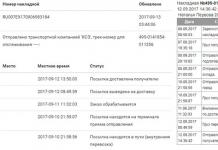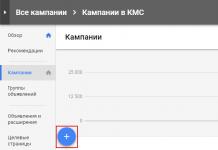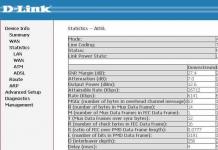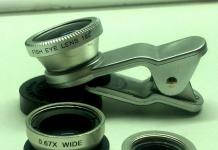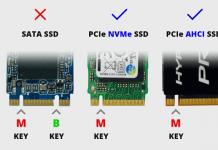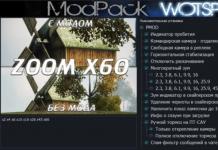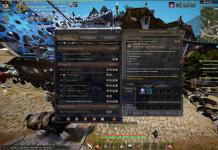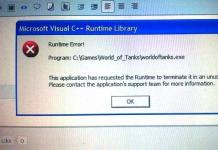Let's consider many ways to get the error "Windows cannot be installed on this disk. The selected disk has a GPT partition style." Previously, there was an old MBR disk partition system and it could no longer operate with the new amount of data TR (terabytes). They came up with the GPT system for disks and it was introduced with the new bisos uefi graphics. Let's approach the presented dilemma using our own, standard means. I would like to note that some users described their actions as simply going into bios and disabling UEFI mode. It all depends on many factors, including the Windows architecture, 64 or 32 bit.
Solutions: Windows cannot be installed on this disk. The selected disk has GPT partition style
1. Change UEFI boot mode
Nowadays, most motherboards support both traditional boot and UEFI Boot. Users can choose the most suitable one in the bios settings. Look carefully! Everyone's bios is different.
- Change value UEFI, instead of CSM in the Feature or Setup section.
- In the Peripherals line, click SATA mode: AHCI instead of IDE.
- (This step is optional, try it if the above doesn't work). In the Key Management line of the Secure Boot function, which is located on the BOOT tab, change Other OS instead of Windows UEFI Mode.
If you record from a flash drive and this method does not work, then rewrite . Unforgettable! Press f10 to save the settings.



2. Removing partitions when installing windows
If you don’t mind the data and want to do everything quickly, then delete all partitions when installing Windows, and then format the entire hard drive. Then re-create the partitions you need. This will create a new table on the hard disk.- Remove all disk partitions.
- Recreate them.
Format ( The method will erase all data).



3. Convert or convert GPT disk to MBR
The method will erase all data.
- When the error appears, click OK to close the error message and press Shift + F10, Shift + Fn + F10 (for laptops) to open cmd (command prompt). If nothing works, then go back a step to the windows installation interface and press the Shift + F10 button to launch cmd again.
- Enter the following commands in order: diskpart -> list disk -> select disk 1 -> clean -> convert MBR. Line translation: diskpart program -> list of disks -> select disk 1 (1 indicates the number of GPT disks) -> clear -> MBR conversion. The picture shows what commands were entered. You can type the codes into a line based on the picture. When the diskpart program converts to MBR format, you can exit the program and continue installing Windows.

4. Use standard disk management utility
If another OS is available on your laptop or it is possible to create a bootable Life DVD or flash drive. You can use the standard Windows disk management program. You can also connect your hard drive HDD to another computer.- To start the program, click "start", right-click on my "computer" or the icon on the desktop, select "Manage" and "Disk Management" from the context menu
- Delete all partitions or volumes on the disk one by one by right-clicking, “delete volume”. (Delete Volume)

- When the disk becomes unallocated, click on the disk and select " convert to MBR disk"(Convert to MBR Disk). After these steps, the original GPT disk will be converted to MBR disk, and then you can proceed to install Windows on this disk.
Quite often, when installing a new “OS” on an “empty” computer or as an additional one, owners of large hard drives are faced with a problem when the system displays a message stating that installing the OS on the selected partition is impossible, since the disk partition style is used as one of the attributes GPT. What this term is and how to solve such a problem will now be discussed. So let's get started.
GPT partition?
First, let's define what this term is. In fact, there is nothing difficult in understanding it.
If it is indicated that the disks selected for have a GPT partition style, this only means that they have an attribute set that allows them to work with volumes greater than 2 TB, and there is a new partition table. If there are standard MBR partitions, the OS itself simply does not recognize a larger volume, and is strictly limited to only four virtual partitions. To overcome these limitations, the GPT partition style is used. But even here there are pitfalls.
GPT partition style, initial conditions for installing the OS in them
To ensure correct installation of the operating system when the selected disk has a GPT partition style, at least two initial conditions are required:
- computer with UEFI BIOS support;
- 64-bit Windows OS version 7 and higher.
Provided UEFI support is available, Windows can be installed on a GPT partition without any problems. If the motherboard does not have such support, even when trying to install a 32-bit system in such a partition, an error warning will be issued. You can work around the problem by converting the partition to a standard MBR, which will be discussed below.
Error correction options
So, if an installation error does appear, you can use several methods to resolve the problem. Among all the options, there are two main ones:
- setting up the initial UEFI BIOS parameters to prepare the system for installing the OS on a GPT partition;
- converting the GPT partition style to MBR at the OS installation stage;
- preparing the disk in setting the parameters of the existing operating system.
Using BIOS UEFI Settings and System GUI
The first option assumes that we have a GPT partition style, the initial conditions are met, and the new OS will be installed on it.

To begin, when starting the computer system, you need to enter the BIOS UEFI settings (special keys or combinations thereof are used for this). If you already have Windows 8 or its version 8.1 installed on your computer or laptop, you can use the universal Charms panel.
In the BIOS settings you should set the following parameters:
- loading UEFI instead of CSM (BIOS Setup or BIOS Features section);
- SATA hard drive mode with AHCI parameter instead of IDE (Peripherals section);
- disabling Secure Boot (exclusively for Windows 7 and below).
After the reboot, the error when installing the system from optical media will no longer appear. However, if you plan to install from a bootable flash drive, it is recommended to rewrite it so that it has UEFI support.
GPT partition style: Convert to MBR when installing OS
As for the conversion, it can be done at the stage. You can change the GPT partition style to a standard MBR using the command line, which at the initial stage is called via Shift + F10 (for some laptops Shift + Fn + F10).

In the console that appears, you should enter the following commands one by one, pressing the enter key after each of them (without the punctuation marks indicated in the list):
- diskpart;
- list disk;
- select disk X (X is the letter assigned to the disk or partition);
- clean;
- convert mbr;
- create partition primary;
- active;
- format fs=ntfs quick;
- assign;
- exit.
Once the commands complete, you can proceed to re-install the same 32-bit operating system into the converted partition without any problems. Please note that during the conversion process, all data in the selected partition will be destroyed.
Converting to MBR on an installed system
If your computer already has an OS installed, conversion to MBR can also be done. There are two tools for this: systems and the command line.

In the first case, by right-clicking on the computer icon, a context menu is called up, where the control line is selected, after which you go to the section. Right-clicking on the selected GPT disk or partition opens a submenu in which the “Convert to MBR disk” command is used.
Note: first, you need to delete all partitions on the disk that you plan to convert (to do this, use the delete volume command in the context menu called by right-clicking on the selected disk).
In the second case, first call the command console (cmd) from the “Run” menu (Win + R), after which the following commands are sequentially written in it (as before, without any punctuation and pressing the enter key after each of them):
- diskpart;
- list disk;
- select disk X (assigned drive letter);
- clean;
- convert mbr.
Once all command processes are complete, you can install a new operating system. And the error message will no longer appear because the GPT partition style attribute is missing as such.
Convert to MBR without data loss
To simplify your work and not use too abstruse Windows tools, you can give preference to third-party powerful utilities.

Most specialists and experts in this field agree that the most suitable software packages are Minitool Partition Wizard, Acronis Disk Director and the like. The conversion technologies are very similar, but working with such utilities is much easier. It is believed that even a novice user can figure them out.
Bottom line
It remains to be stated that if there is support for initial conditions, it is better to use a GPT disk by making simple settings in the BIOS UEFI. In all other cases, you cannot do without converting to MBR. And if you are installing Windows for the first time, it is better to immediately change the partition. In case of re-installation or replacement of the OS, the second method is also suitable.
And one more detail. When purchasing or installing a new hard drive with a capacity of more than 2 TB, it is recommended to first make sure that the entire computer system meets the initial parameters and that the motherboard supports UEFI. Only in this case is its correct operation guaranteed. Moreover, this applies not only to the installation of the OS, but also to the subsequent saving of user information on it.
The development of computer technology not only implies an increase in computing power; along with increased productivity, there are improvements in the stability, security and convenience of modern computers. One of the most significant changes that have occurred in recent years has been the replacement of the old BIOS with a more advanced UEFI, as well as the transition from MBR to GPT disk partitioning style.
The advantages of the latter style are obvious. Unlike MBR, GPT partitioning allows you to create an almost unlimited number of partitions and assign them unique identifiers, names and attributes. GPT also supports duplicating the boot code and partition table, and works without any restrictions with media larger than 2.2 TB. However, the GPT partition style also has its drawbacks, the most significant of which is the lack of support for this technology on computers with an old BIOS.
In addition, novice users may have difficulty installing Windows on a GPT disk. Thus, due to the incompatibility of the BIOS software or some of its settings with modern drives, when you try to install the system on a disk with a new partition style, the error “Windows cannot be installed on this disk is possible at the initial stage.” The selected disk is in GPT style."
To users inexperienced in computer subtleties, the error may seem serious; in reality, there is nothing here that could prevent the installation of the system.
The message “Windows cannot be installed, the selected disk has a GPT partition style” usually occurs on new computer models with large disks or, conversely, on older PCs after replacing the disks with newer drive models. In this case, the version of the operating system does not play a special role; an error can occur when installing both Windows 7 and Windows 10, although, according to numerous evidence, the error is more often encountered when installing Windows 7. Currently, there are two main solutions to this problem - changing the appropriate settings in the UEFI BIOS and converting the GPT style to MBR.
Setting up UEFI and installing Windows on a GPT disk
This method is only applicable to computers with UEFI firmware, so the first thing you need to do is make sure that it really is present. If you see a graphical interface with mouse support when you enter the BIOS, it is more likely that your PC is running UEFI firmware, hence you can install the system on a GPT drive. You can get into the new BIOS in the same way as into the old one - just hold down the F2 or Del button during boot.

Next, in the BIOS Features or BIOS Setup section, you need to find and enable UEFI boot instead of CSM, and in the Peripherals section, select AHCI instead of IDE for the SATA operating mode. If you are installing Windows 7 or an earlier version of the system, you must also disable the Secure Boot feature (usually located in the Boot section).

After these manipulations the message “Windows cannot be installed. GPT Partition Style" should no longer appear.
Important: The system installed on a GPT disk must be 64-bit, these are the terms of Microsoft policy. If you want to install a 32-bit version of Windows, the partition will have to be converted to MBR. If the system is installed from a flash drive, it is recommended to recreate it so that it supports UEFI. To do this, you can use the command line, or even better, the special Rufus utility.
Converting GPT markup to MBR
If your PC is using a regular BIOS, installing Windows on a GPT drive will not be possible. In this case, the most correct solution would be to convert the GPT style to MBR immediately before installing the system. If you receive a notification that Windows cannot be installed, close the wizard window and click Shift + F10. In the command line that opens, run the following commands sequentially:
diskpart
list disk
select disk 0
clean
convert mbr
The first command launches the utility Diskpart, the second displays a list of all physical disks connected to the PC, the third command selects the desired disk (in this example, it is disk 0), the fourth completely cleans it (all created partitions are deleted), the fifth command converts the GPT partition style to MBR. When executing the list disk command, pay attention to the asterisk in the GPT column, it just indicates that the disk has the GPT style.

To make sure that the conversion was successful, you can display the list disk again - the asterisk in the GPT column should disappear. That's all, use the exit command to exit the Diskpart utility, close the command line and continue installing Windows, after restarting the computer. After cleaning, the partitions will have to be created again, but this time no notifications about the impossibility of installing on the selected partition should appear, since the disk will already have MBR partitioning.
Using third party programs
It is unlikely, but it may happen that you will need to convert the GPT partitioning style to MBR on a disk with data already on it. The method described above using Diskpart is not suitable in this case, since the clean command removes all partitions from the disk, and along with them the data they contain. In such a situation, you can use third-party applications, for example, Minitool Partition Wizard Bootable, Paragon Hard Disk Manager or AOMEI PE Builder.

All of these programs allow you to convert a basic GPT disk to MBR and vice versa, and the conversion procedure is simple and accessible to users with any level of experience.
Installing the system in unallocated space
In some cases, you can do without using the command line or additional applications. If, when installing Windows 7/10, the wizard writes “installation on this disk is not possible,” and the disk size does not exceed 2.2 GB, it is worth trying this method. Using the installation wizard, delete all created partitions and try installing Windows into a single unallocated space.

If no error occurs, the system itself selected the MBR style and converted the disk to it. However, in this case, you will have to create the user partition D separately after installation. Also, you will not have a hidden “System Reserved” partition on the disk, which will somewhat reduce the fault tolerance of Windows.
When preparing to install Windows 10 or during the process itself, problems may arise that prevent you from completing the update procedure. There are times when the installation freezes, is interrupted, displays an error, and other similar situations, from which you can recover yourself using the instructions below.
Problems before system installation
To install the system, you need installation media, which is recommended to be created using the official Microsoft program. After you install it, go through the first steps with choosing parameters and system capacity, you will be asked to choose which of the connected media to turn into installation media. The list provided by the program may not include the flash drive that you wanted to use for further installation of Windows 10. This can happen for the following reasons:
- The flash drive was not properly prepared. The flash drive must be empty, formatted in FAT32 or NTFS format and have at least 4 GB of total capacity. If at least one of the parameters is not met, then the Windows 10 setup program will not see the flash drive;
- The USB port into which the flash drive is plugged is faulty, try moving it to another port and check the result, remembering to restart the program;
- restart the computer, perhaps there are some unfinished operations being performed on the flash drive, so you cannot work with it, and after restarting the device they will all be completed;
- check whether the computer itself sees the flash drive, if not, then the problem and the reason lies there;
- if all else fails, then replace the flash drive or use any other method of turning it into installation media, for example, download a system image and burn it manually.
Endless updates
If, during the process of creating bootable media with a new operating system, updates are being searched for an infinitely long time, you need to close the update center:
Problems during the installation process
All of the following errors and problems occur during installation: freezing, interruption, incorrect outcome of the process, etc.
The disk contains an MBR partition table
This error occurs when selecting a disk or partition designated for installing the operating system itself. It appears due to the fact that the hard drive is formatted in a format that does not correspond to the mode set in the BIOS. There are two ways to get rid of this error: change the operating mode in the BIOS or reformat the disk. The second option is recommended, since the mode selected by default in the BIOS is the most optimal. You can reformat the disk in the standard way, but at the same time losing all data from it, or using a third-party program, interrupting the installation process, but saving all the information.
 Error: Windows cannot be installed on this disk. The selected disk contains an MBR partition table."
Error: Windows cannot be installed on this disk. The selected disk contains an MBR partition table." Changes to BIOS settings
By default, EFI mode is activated in the BIOS, which only works with disks in GPT format. Since your drive is in MBR format, you will have to change the mode to Legacy. To do this, turn off the computer, start turning it on, and as soon as the first signs of booting appear, press the F11, F12 or ESC key to activate the Boot Menu. Which of the possible buttons will be assigned in your case is described in a small footnote that appears on the screen when loading begins. In the drop-down list, you will need to select your flash drive, but without the UEFI or EFI prefix in the name.
 We change the boot order so that the first place is a flash drive without UEFI and EFI
We change the boot order so that the first place is a flash drive without UEFI and EFI You can also change the boot order in the BIOS itself, in the Boot or “Boot” section, putting the name of the flash drive in first place without the UEFI and EFI prefixes. After this, all that remains is to exit the Boot Menu or BIOS, after saving the new settings. Done, you can continue installing Windows.
 We put a flash drive without a UEFI and EFI prefix in first place
We put a flash drive without a UEFI and EFI prefix in first place Changing the disk format to MBR using the standard method
Format changes will be made via the command line. The disadvantage of this method is that you will have to delete all the data on the disks, so copy it to another medium in advance to save it.

Changing the disk format to MBR using a third-party program
To convert using a third-party program, you can use the Minitool Partition Wizard Bootable application, the image of which must be downloaded from the official website of the developer and written to a flash drive formatted in FAT32 format. The advantage of this method is that you don't have to delete data from the disk to convert it.

Once the drive is converted to GPT format, enter the Boot Menu again and boot from the installation media to return to the Windows 10 installation.
The system does not install on the SSD disk
The reason why you cannot install Windows on an SSD drive is most likely that the BIOS operating mode is set to IDE instead of the required ACHI. To fix this, follow these steps:
- While turning on your computer, press the Delete key on your keyboard several times to enter the BIOS. Another button can be used to enter the settings menu, it depends on the motherboard model, but when the computer boots, a footnote appears on the screen that will tell you how to enter the BIOS.
 Entering the BIOS
Entering the BIOS - Once you enter the BIOS, you will see either the stock BIOS or a newer UEFI version. There are also possible options for the presence of the Russian language and its absence. Partitions in different BIOS versions may have different names, so your main task is to find the mode switch from IDE to ACHI. In one version of UEFI this is done like this: first go to the Setting section.
 Go to the Settings section
Go to the Settings section - Go to advanced settings.
 Open additional settings
Open additional settings - Open the “Embedded Peripherals” subsection.
 We enter the section “Built-in peripheral devices”
We enter the section “Built-in peripheral devices” - In the “SATA Configuration” block, find the required line and change the mode to ACHI. Done, all that remains is to exit the BIOS, saving all the changes made, and you can return to installing the new OS.
 Changing the SATA mode to ACHI
Changing the SATA mode to ACHI
If changing the mode does not help, then the reason can be looked for in the following parameters:
- There are several disks connected to the computer, this may cause the installation to fail, so leave only one of them and try the installation again;
- The flash drive from which the installation was carried out was formatted in NTFS format, and not in FAT32, suitable for SSD drives. In this case, you need to reformat the media and write the system image onto it again;
- If none of the above helped, then try installing from disk, sometimes this helps solve the problem.
Blue screen appears during installation
A blue screen with text and a description of the error occurs when the installer encounters an insurmountable error and cannot continue the process. In this case, it will automatically erase all already installed update files and roll back the system to the moment when the installation procedure had not yet begun.
 Installation aborted due to blue screen
Installation aborted due to blue screen After the rollback is complete, you can start the installation again. Perhaps this time it will be stable. If not, the blue screen appears again, you need to return to the system already existing on the disk and delete all unnecessary applications in it and disconnect all unnecessary devices connected to the computer. Most likely, the system cannot install updates correctly precisely because of third-party programs and devices.
If this does not help, then copy all important information from the disk to third-party media, and proceed to manual installation, during which you can delete all information from the disk. Do just that, erase all data from the disk partitions and install Windows 10 on a clean partition.
A black screen appears during installation
If during installation of the system a black screen appears on which nothing is displayed or only the mouse cursor is displayed, then there may be several reasons for this behavior of the computer:

But before solving the problem, just wait, the system may still be performing the update process in the background. You should only think about solving the problem manually if the black screen does not move for more than half an hour.
Driver Update
- To enter Safe Mode, we will use the Command Prompt. To call it, return to the Windows 10 setup program again, to do this, turn off the computer by holding the Power button for 10-15 seconds and turn it on. Once the program is open, use the key combination Shift+F10 to launch the Command Prompt.
 Activate the command line with the combination Shift+F10
Activate the command line with the combination Shift+F10 - Run the command bcdedit /set (default) safeboot network, then the command shutdown /r and, when asked, confirm the action by pressing the Enter key again. The computer will reboot itself and turn on in safe mode.
 Run the commands bcdedit /set (default) safeboot network and shutdown /r
Run the commands bcdedit /set (default) safeboot network and shutdown /r - When the startup is complete, open the device manager, find the video card in the general list and right-click on it and select “Update drivers.” Go through the automatic update process or, if the computer cannot find the drivers itself, download them from the official website of the company that created the video card and install them manually.
 Update video card drivers manually or automatically
Update video card drivers manually or automatically - Once the driver update is complete, run Command Prompt as an administrator, run bcdedit (default) /deletevalue safeboot to disable automatic startup in safe mode, shut down your computer, and return to the Windows 10 upgrade process.
 Run the command bcdedit (default) /deletevalue safeboot
Run the command bcdedit (default) /deletevalue safeboot
What to do if the installation process freezes
The installation process may freeze at the following stages:
- when the Windows logo appears;
- at the stage of file preparation;
- right during installation, when the screen displays that the process is 0, 10, 99, 32% or another percentage complete.
Keep in mind that the installation process can remain at one percent for up to several hours if the computer is not particularly powerful or is overloaded with files. Therefore, first wait at least two hours, and only if nothing happens after that, you can proceed to manually fix the problem.
It’s impossible to say for sure why the freeze happened in your case, so check all the options that could cause the freeze, one by one:
- Disconnect all unnecessary devices from the computer, leaving only the keyboard, mouse and monitor connected. Also remove any excess SATA cables going to the CD port and USB flash drives.
- Check that the BIOS settings are correct and that the installation media is in the correct format. Remember that the parameters will be different for SSD and HDD disks, BIOS and UEFI, GTP and MBR formats. Somewhere you need to enable ACHI mode, and somewhere IDE, somewhere you need to format it in FAT32, and somewhere in NTFS, and so on. Based on the type and format of the hard drive, as well as the BIOS version, find the specifications suitable for your build on the Internet and install them.
- Before you upgrade to Windows 10, be sure to install all available updates on your existing operating system. This can be done through the built-in Update Center program, which is present in Windows 7, Windows 1, and older versions.
- If the installation freezes when using a USB flash drive as installation media, try installing from a CD.
- Don't forget to make sure that your computer meets the minimum requirements for Windows 10, they are presented on the official Microsoft website.
- If you can’t install the system on top of the old, already installed Windows, then at the step of managing hard drive partitions, format all the blocks and install Windows 10 on a completely blank disk.
- If you are not installing the system on a clean hard drive, then remove the antivirus; it may interfere with the update. Also erase all programs that make changes to the interface and other system parameters of the system.
Error: "Could not create new partition"
When installing Windows manually, sometimes an error appears stating that it is impossible to create or find an existing partition. It appears because there is no unallocated memory or partitions on the disk that could be allocated for installing the operating system. The way out of this situation is to create the necessary partitions manually. This can be done in two ways: by deleting existing partitions and creating new ones, or by reducing existing partitions and distributing freed memory.
 Error "We were unable to create a new partition or find an existing partition"
Error "We were unable to create a new partition or find an existing partition" Standard method
You can delete partitions and create new ones right in the same window in which you received the error.

Via command line
Using the command line, you can not delete partitions, but compress them without losing the files that are on it.

The installation causes the computer to restart repeatedly
It is normal for your computer to reboot during installation; it may reboot five to six times to get everything configured correctly. But if this operation is repeated too many times, then you need to interrupt the process manually, return to the already installed system and perform the following steps:

The installation program window does not appear
If you are faced with the fact that the installation program window does not appear, then follow the instructions from the paragraph “What to do if the installation process freezes,” described above in the article.
 The installation window did not appear after booting from a flash drive
The installation window did not appear after booting from a flash drive Device drivers not found
An error stating that device drivers were not found appears when you try to install Windows 10 for the following reasons:
- USB0 flash drive is connected to port 3.0 or, conversely, USB 3.0 flash drive is connected to port 2.0. Switch it to the desired port and repeat the installation.
- The system image was recorded incorrectly or was damaged from the start. Rewrite it. It's better to use a non-standard Microsoft program and burn the image using UltraISO.
- Use a disk for installation, not a flash drive.
Bottom line: Use a different media, port, or image to get rid of this error.
Code errors when installing Windows 10
If errors occur during the installation of Windows, the description of which contains a unique code, then the best way out in this situation is to search for a solution using this particular code. Based on the unique number, which usually looks like 0xc1900101, you can find a solution specifically for your case. If it is not available on the Internet, then contact the official Microsoft support service and tell them this code, they will provide you with instructions for further actions.
 During installation of Windows 10, an error with the code may appear
During installation of Windows 10, an error with the code may appear Video: problems during installation of Windows 10 and their solutions
So, if errors occur during the installation of Windows 10 or the process does not complete, freezes or is interrupted, then first of all you need to check that the BIOS, installation media and hard drive are configured correctly. The next step is to check the computer components and drivers for them. The best way out is to clean the disk by formatting and install the system on a clean partition using the official Microsoft program.
Users who install the latest three versions of Windows operating systems – 7, 8 or 10 (any build) – can see a message on the screen with the text “the selected disk has a GPT partition style.”
The problem is the incompatibility of outdated laptop or computer software with more modern drive characteristics.
The choice of a specific solution to the problem primarily depends on the bit depth of the Windows system being installed and the firmware interface (BIOS or UEFI).
What are GPT and MBR?
Before you continue installing the operating system on your PC and converting partition styles, it is worth finding out what is causing the problem.
Thus, most relatively old motherboards were equipped with BIOS software, the tasks of which were primary diagnostics and loading of the operating system.
By the way, you can read on our website.
The software was designed to work only with MBR boot records.
A newer version of the interface, UEFI, allows you to work with both old styles and new ones, GPT.

Rice. 1. Error when installing Windows on a disk with GPT partition style.
The advantages of the updated software are increased loading speed and data security - due to more reliable loading and support for hardware encryption of drives.
In addition, UEFI works with the GPT style, which supports writing and reading large files. This is especially important for hard drive sizes larger than 1 TB.
You should know: UEFI is compatible with both BIOS and MBR. This means that when working with the new interface, the disk style does not matter. At the same time, the BIOS does not work with either UEFI or GPT.

Rice. 2. Defining disk styles using special utilities.
Options for solving the problem
As a rule, most more or less new motherboards are already equipped with a modern interface.
And problems with installing an operating system due to the GPT style can appear only in two cases - if the computer is relatively old or the UEFI settings do not support the new style.
The first version of the problem can be solved in only one way - by changing the hard drive settings.
As a result, it will be more difficult to work with large files, but you will be able to install the system.
If the problem is that GPT support is disabled, you just need to enable it and continue installing the platform.
Installing the system on GPT disks
It is advisable to solve problems with installing the system on a HDD with GPT partitions by observing the following conditions:
- Using a 64-bit system;
- By setting the boot mode to UEFI.
However, most often the cause of the error is the failure to fulfill the second condition, since it hardly makes sense to install a 32-bit system now (except for computers with 32-bit processors).
To correct the situation, you will either need to change the BIOS settings, or prepare it in such a way that it supports working with UEFI automatically.
Setting up BIOS or UEFI
The first steps that should be performed when installing Windows of one of the last three generations on a PC is (or, more precisely, UEFI).
This usually requires pressing a certain key while the operating system is loading.
In Windows 7, you most often need to press Esc, F1 or F2, depending on the motherboard manufacturer.
For Windows 8, this will require changing the system boot settings (through additional options in the Diagnostics menu, called up by pressing the Win + C keys).

Rice. 3. Enter the Windows 8 system boot change menu.
For Windows 10, to enter the UEFI settings you will have to run:
- Click on the notifications icon and select settings;
- Go to the update and security window;
- Select recovery partitions, special boot methods and immediate reboot one by one;
- After the system has rebooted, select advanced options and UEFI settings.
Now that the BIOS has turned on, you should configure its menu to automatically install the new system on GPT disks.
To do this, the user must install UEFI boot instead of the standard CSM.

Rice. 4. Installation of loading the new UEFI interface.
The second step is to select the appropriate disk operating mode - instead of IDE, designed for the old type of HDD, you should choose.
Configuration can be done in the Peripherals or SATA Configuration menu.

Rice. 5. Setting the operating mode for SATA drives.
Sometimes, for Windows 7, you need to additionally disable such an option as UEFI.
You should know: In different versions of UEFI, all these items may be located in different places. However, the names of the settings are saved and are relatively easy to find.
You may be interested in:
Possible installation problems
After making all the changes, just save them and restart your computer (or laptop). There should be no error messages or other similar problems.
If problems still persist, you should fix them by creating a special boot disk.
One of the easiest ways to do this is to use the command line or special programs like Rufus.

Rice. 6. Create a boot disk that supports GPT by default.
When using such a drive, the probability of error-free system installation is almost 100 percent.
However, to be on the safe side, you should perform one more action - delete the bootmgr file in the main directory of the USB flash drive, which may lead to another attempt to boot without GPT support.
Now the system will install without errors.
Converting a disk from GPT to MBR
In the absence of the ability to configure UEFI, and especially in the complete absence of this interface, the user has no other option but to change partition styles.
To do this, you can try to use the already built-in tools of the installed operating system or special utilities.
Important: If necessary, the methods for changing styles back from MBR to GPT are just as simple. Moreover, the data written on the disc is not lost, unlike conversion to an older format.
Conversion via command line
An option to change the disk style, suitable for computers with an outdated boot interface and, especially, an old type HDD (IDE).
A necessary condition for performing such actions is that the hard drive partitions must be empty, since all data is deleted during the conversion process.
If the information on the disk is not needed by the user, it does not need to be deleted.
To change the style to the MBR, the person installing the operating system will need to do the following:
- When selecting a partition type during system installation, press the Shift and F10 keys;
- In the command line that opens on the screen, enter two commands - first discpart, then list disk;
- After the list of hard disk partitions appears, write select disk A, where A is the number of the part that should be converted to GPT.
The user's next actions can continue by entering the clean command. In this case, all partitions of one of the disks will be deleted.
The second option is manual removal, which requires entering three commands in turn (detail disk, select volume, delete volume).
The last stage is changing the style. To do this, enter another command in the line - convert mbr.
After manual conversion to MBR has been completed, you need to:
- Enter one more final command Exit ;
- Close command prompt;
- Divide the disk into new partitions (it is advisable to leave a smaller part of the HDD for the system and applications, and a larger part for storing important information);
- Continue installing the operating system.
As a rule, no errors occur in this case.
The only reasons for continued problems are problems with the hard drive or a corrupted software distribution.
In the first case, you will have to contact service to fix the problem, in the second, use another installation disk.
Selected disk has GPT partition style when installing Windows
Attention: this is not the only way to solve the problem: you can also simply enable EFI boot for the installation drive without converting the HDD.
Convert to MBR in Disk Management menu
The second option for manually switching from GPT to MBR is suitable for computers on which a working Windows 7 or 8 is already installed, and the disk is not a system one.
To resolve the issue, the user is required to:
1. Go to the disk management menu (one of the simplest options is through the run window, in which you should enter the command diskmgmt.msc);

Rice. 7. Disk management menu.
2. Find a physical (that is, not a partition, of which there can be many on an HDD) hard drive that will be converted;
3. Delete all partitions from the HDD by selecting the delete item in the menu;
4. Right-click on the disk name and select conversion to MBR.
5. Restart your computer and continue installation.
Convert GPT HDD to MBR Basic
Convert a GPT hard drive to MBR (basic) using Paragon Hard Disk Manager.
Style conversion utility
In addition to standard methods involving the use of built-in Windows tools, there is also the opportunity to simplify your task using special utilities.
Some of the most convenient are Minitool Partition Wizard and Acronis Disk Director. The downside to these apps is that you have to pay to purchase them.
While downloading the Aomei Partition Assistant program can be done completely free of charge.
And among the many possibilities, there is not only changing styles, but also other options for customizing hard drives.

Rice. 8 Working with the Aomei Partition Assistant utility
You should know: When using applications that allow you to change hard drive style settings, you can delete the first boot partition of the HDD. In this case, converting GPT to MBR and back will be much easier.

